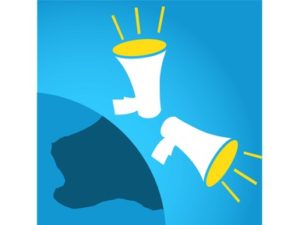From identifying your goals for your website, to evaluating resources, organising content, determining your site’s tone and voice and keeping your site up to date, this step-by-step section will help ensure that your website works effectively for your organisation.

In this section, we will cover the 10 steps to rethinking your website.
STEP 1: Identify your goals and objectives
STEP 2: Evaluate what resources you have
STEP 3: Look for examples to inspire and inform your plans
STEP 4: Organise your content
STEP 5: Determine what current content and evergreen content will populate your site
STEP 6: Decide how you will highlight social media on your site
STEP 7: Decide how you will deal with language barriers
STEP 8: Articulate the tone of your website
STEP 9: Evaluate whether you need to hire outside help
STEP 10: Keep your site up to date
STEP 1:
IDENTIFY YOUR GOALS AND OBJECTIVES
A GOAL is the long-term purpose towards which your efforts are directed.
AN OBJECTIVE is a mid- to short-term specific, measurable action that moves you forward on the path towards your longer-term goals.
Your organisation’s vision and mission set out overarching long-term goals for your efforts. For instance, in IFEX’s case, the organisation’s goal is to defend and promote freedom of expression as a fundamental human right.
Your communications plan should set out communication objectives.
Your digital communications plan should set out specific digital objectives.
EXAMPLE: If you are rethinking your website, your objective in your communications plan may be: Relaunch website by September.
Your digital communications plan would then break this objective down into a series of specific digital objectives. As an example, these could include the following, though your organisation’s list might be different depending on the scope of your project:
- Analyse current website audiences and evaluate against target audiences by March
- Articulate content objectives for specific audiences by April
- Review website structure and create new wireframes by June
- Work with web designer and technical team to build and populate website through July and August
- Relaunch website in September

TIP
Your audience is made up of people you want to:
- inform: provide information to.
- transform: change their attitudes through compelling storytelling, data and arguments.
- motivate to act: prompt them take a specific action, such as signing a petition or writing a letter to a legislator, by providing the information and tools they need to do so.
EXAMPLE: Sometimes a redesign is a good opportunity to examine whether your existing design unintentionally places barriers that prevent your audiences from being informed, transformed or motivate to act. When Venezuela IFEX member Instituo Prensa y Sociedad (IPYS) redesigned their website, they removed a barrier to action. They made their freedom of expression violation reporting system confidential because they recognised that lack of confidentiality was a concern for users.
As you plan your site’s content, consider:
- what audiences you are trying to reach,
- how you want the information you share with them to inform, transform or motivate them to act.
For more information on understanding audience and defining key messages for your audience, refer to IFEX’s Communications Strategy Step by Step document.
STEP 2:
EVALUATE WHAT RESOURCES YOU HAVE
Be realistic about what you can take on. Money, staff time, volunteer time and the technical ability needed to achieve your goals and objectives can all be in limited supply. Be certain to take the post-launch maintenance and ongoing effort required to keep your website up to date into account as you make your plans. This will vary depending on what you take on and the skill levels of your staff.
Ask yourself: Are your plans realistic? Researching and writing one new article or blog post can take half a day or more of a staff person or volunteer’s time. If your plan for your homepage is requires that you have three new article per week,, have you taken into account the resources that will be required to create that content? If your design is based on having images to promote stories in a rotating homepage carousel, will you reliably have access to good-quality images?
STEP 3:
LOOK FOR EXAMPLES TO INSPIRE AND INFORM YOUR PLANS
Best practices:
Where can you turn for resources and inspiration? As you begin to develop your social media plan, it is useful to have a sense of what is possible.
- Look at the websites of organisations that are similar to your organization. Who are you competing with for your audience’s attention? What are they doing that you should consider for your website?
- Look at the websites of sector leaders. You may not be able to do everything that they do on their sites (frequency of updates, sophistication of content presentation), but you can learn lessons about best practices from them. For instance, you may notice that they include related links on key stories, so that users always have more content to explore. You could adopt this strategy without adding significant expense to your efforts.
- Study websites outside of your sector that you personally find useful or enjoyableto spend time on. Ask yourself: What makes this site enjoyable for me? What can I learn from this site that I can apply to my own organisation’s site? Also look at examples of sites created using widely available website templates such as Wordpress and Squarespace.
STEP 4:
ORGANISE YOUR CONTENT
Two key questions should guide you in organising the content on your website:
- What are you communication goals?
- What will your audience(s) be looking for?
Remember that your audience is made up of people you want to inform, transform or motivate to act. Consider how best to organise your content to meet your informational, transformational or action goals and objectives.

TIP
You may want to survey your users or test your content to determine the most effective way to organise your content. When IFEX member IPYS Venezuela redesigned their website, they used a questionnaire to ask users about the site’s usefulness and to take suggestions for improvements. They also did a classroom-based usability test, where the behaviour of six users was monitored and analysed to provide insights for the redesign process.

TIP
In the past, many organisations based their homepages on their internal departments and structures. Content was sorted according to internal structure, or by broad categories such as news, publications and projects. However, this structure neither enhances your communication goals nor reflects what your audience is seeking.
| If your key goals are: | It may make sense to organise your content under the headings that clearly reflect your goals: |
|---|---|
| Advocate for better free expression legislation | Legislation |
| Protect the rights of journalists | Rights protection |
| Monitor free expression violations | Free expressions violations |
If you are a group that covers a number of countries, and you know that your audience comes to you to find information about specific countries, you might consider organising your content by country.
EXAMPLE: IFEX homepage
In redesigning its site, IFEX wanted to emphasise key issue areas. IFEX also recognised that its audiences frequently searched for content by specific region or country. This led the team to organise content under two navigation bars, one for Issues and one for Regions.
See the IFEX homepage
HOMEPAGE CONTENT ORGANISATION
How does your homepage relate to internal pages of your website?
Many users come directly to your website’s internal pages—via search or social media—and never see your homepage. So why does your homepage matter? Because the thought you put into organising content on your homepage will carry through to your internal pages, by:
- Pushing you to be clear about your communication goals and objectives
- Forcing you to consider what kind of content your audience would be looking for and how best to organise that content so that it is easily for them to find
- Helping you to lock down key elements of the overall structure that will be carried onto internal pages
What homepage elements are carried through to your internal pages? Usually, the header, navigation bar and footer will remain consistent across all or most of your website’s pages. In some cases, the content in your right rail (less frequently, a left rail) may also be consistent across all pages. Getting these elements right on your homepage allows you to get them right—and keep them consistent—across internal pages as well.
STEP 5:
DETERMINE WHAT CURRENT CONTENT AND EVERGREEN CONTENT WILL POPULATE YOUR SITE
“Evergreen” content borrows its name from evergreen trees, which stay green and keep their foliage year-round. Content is considered evergreen if it remains useful and relevant for a long period of time and does not require frequent updates. Most website content falls into one of two categories:
CURRENT CONTENT
- DEFINITION: Content that is created to reflect a current set of circumstances or news and which becomes dated as time passes
- EXAMPLES: News reports; Free expression violation alerts
- PURPOSE: Conveys the most up-to-date and breaking news
- WEBSITE VALUE: Keeps your website current and up to date, but is relatively high maintenance, because it must be frequently updated: has a short useful lifespan
EVERGREEN CONTENT:
- DEFINITION: Reference, resource or background material that stays relevant for a longer period of time and does not need to be updated as frequently as current content.
- EXAMPLES: Historical information and background; Resource material
- PURPOSE: Captures knowledge that remains useful despite the passage of time
- WEBSITE VALUE: Creates a robust base of content that is relatively easy to maintain because it does not need to be frequently updated: create once and use for a long time.
As you evaluate the content that is already on your website to determine what should be kept or dropped as you rethink your website, consider what current and evergreen content you have.

TIP
Don’t think you have any evergreen content? Step back and evaluate whether you can create evergreen content by:
- Pulling a number of current reports on an issue or country together to create a history of an issue or backgrounder on an issue in a particular country
- Creating backgrounders on key individuals, pieces of legislation, existing regulations and other material pulled from current reports
STEP 6:
DECIDE HOW YOU WILL HIGHLIGHT SOCIAL MEDIA ON YOUR SITE
How and where will you highlight your social media efforts on your site? Based on these insights, they developed a list of factors that influence sharing:
- Social media connection points: Highlight your main social media channels on your homepage, with buttons to link users to your social media pages, as IFEX member Derechos Digitales does. These may be part of your standard page structure, showing up in the same spot on every page of your site. IFEX has done this, by putting the social media links in a bar above the main header bar on each page. See the IFEX website.
- Social media content: If you are very active on a particular social media platform, you may decide to use a “plug-in” or “widget” to insert your latest updates onto your homepage or as part of your standard page structure. This is a particularly useful strategy for organisations that do not have the resources to create frequently updated website content, because the frequent change in your social media updates also results in a change to the content on the pages that include your social media plug-in or widget. You may also decide to have your social media content show as a “tickertape” on a page, as IFEX has done on the bottom of its homepage. See it at the IFEX website.
- Shareability: Adding social sharing buttons to content pages makes it easier for users to share that content, since they can do it in a click or two rather than having to copy and paste the page link.

TIP
Notice that the icons for key social media platforms are easily identifiable. Users look for these images when they are scanning pages for social media links.
STEP 7:
DECIDE HOW YOU WILL DEAL WITH LANGUAGE BARRIERS
While imperfect, tools such as Google Translate have made it easier for users in many languages to access content in other languages. Still, there may be cases where it makes sense for your organisation to provided content in more than one language.
In IFEX’s case, the decision was made to make the homepage and certain key pages available in English, French, Spanish and Arabic. See the pages at:
For IFEX, individual articles are posted in language of origin where feasible, with translations indicated where available.
STEP 8:
ARTICULATE THE TONE OF YOUR WEBSITE
The tone of content on websites can be somewhat less formal than the tone of printed material. However, for most organisations, it is still important to be seen as credible and authoritative, so the content you post should be created or chosen with those goals in mind.
Come up with a list of adjectives that describe your site’s tone. Your list might include words such as:
- credible
- intelligent
- energetic
- enthusiastic
- friendly
There may also be words that would definitely not apply to your site. For instance, many sites avoid being witty or humorous because of the possibility that users will misunderstand the humour.
Capture your tone in three or four adjectives, along with a couple that definitely should not apply. This can be helpful in establishing guidelines for the tone of content on your site.

TIP
The display copy—headlines, pullquotes, subheads—on your site is key to conveying the tone of your site. As your team creates this display copy, ensure that the words chosen align with the tone you are trying to convey.
STEP 9:
EVALUATE WHETHER YOU NEED TO HIRE OUTSIDE HELP
Hiring help—working with consultants: Most organisations will need to hire outside consultants to assist them in rethinking their websites. These could include:
- Communications or digital consultant to assist with overall content planning, audience analysis and evaluation of website analytics
- Website designer to assist with web design
- Website developer to carry out the actual coding and building of the site
- Social media consultant to provide input on appropriate social media opportunities and strategies
How can you ensure that your working relationship with your consultant(s) is successful?
- Define the project’s scope clearly: Be clear about what you need help with: the goals, objectives, timelines and budget.
- Define the consultant’s role clearly: Write a description of exactly what tasks you expect the consultant to complete.
- Take the time to find the right consultant: Ensure that the consultant has the skills and experience required. Also consider if the consultant is a good fit with your organisation: does the consultant understand your issue area and/or organisational culture?
- Have a contract: Set out key deliverables, deadlines and payments in a contract or letter of agreement.
- Assign an internal point person as the key liaison with the consultant: Having one clear point of contact will improve communication and accountability.
- Ensure that your organisation is committed to getting the work done: Is your organisation ready to get this work done? Ensure that you have internal buy-in and commitment to the project, or you will find it difficult to keep the project on track internally. This could lead to cost overruns as your consultant wastes time waiting for your organisation to make decisions and move forward.
- Monitor progress and keep communication open: It is ideal to set up regular check-ins (in person, electronically or by phone) to track project progress. Ensure that the internal liaison person is available to the consultant as needed, and that the consultant is providing you with required project updates.
- Have an exit plan: Ensure that mechanisms for terminating the agreement or contract are clearly outlined, should it be necessary to end the arrangement.

TIP
Hiring a consultant is not a substitute for developing internal familiarity with an issue or project: you will still need to have someone internally who already has some knowledge in the area or is willing to develop enough knowledge to successfully manage the project.
STEP 10:
KEEP YOUR SITE UP TO DATE
It may be tempting to think that once your site is relaunched, it is “finished.” But a website should constantly evolve and be updated. As you make plans to rethink your website, consider your post-relaunch plans for keeping content up to date and refreshed. Create a content calendar, with specific dates for the launch of current content, and with target dates for reviewing and updating evergreen material.
Conclusion
Website standards are constantly evolving, and your website will need to evolve along with them. The principles presented here should apply even as the functionality of websites advance. The keys?
- Align your digital communications strategy with your overall communication strategy and organisation’s mission and vision
- Understand who your audience(s) is and what they want and need from you
- Focus on developing content that matches your audiences’ needs and your organisation’s goals

Website Optimisation Plan
This 10-step plan will help you improve your website’s impact and usability.
Chapters

Organisational Strength Map
Use this tool to identify your organisation’s strengths and explore areas for growth and development.
Strategic Planning Toolkit
Build your strategic plan and improve your organisation’s effectiveness with these strategic planning tools and fact sheets. Not sure where to start? Check out the Starting Points page for advice tailored to your situation.

Communications Strategy Toolkit
Effective communications planning will enable you to raise your organisation’s voice on issues that matter.

Financial Sustainability Plan
Ensure that your organisation survives and thrives by strengthening its fiscal framework.

Social Media Strategy
This step-by-step tool will enable you to build an effective social media strategy and engage your online audiences.